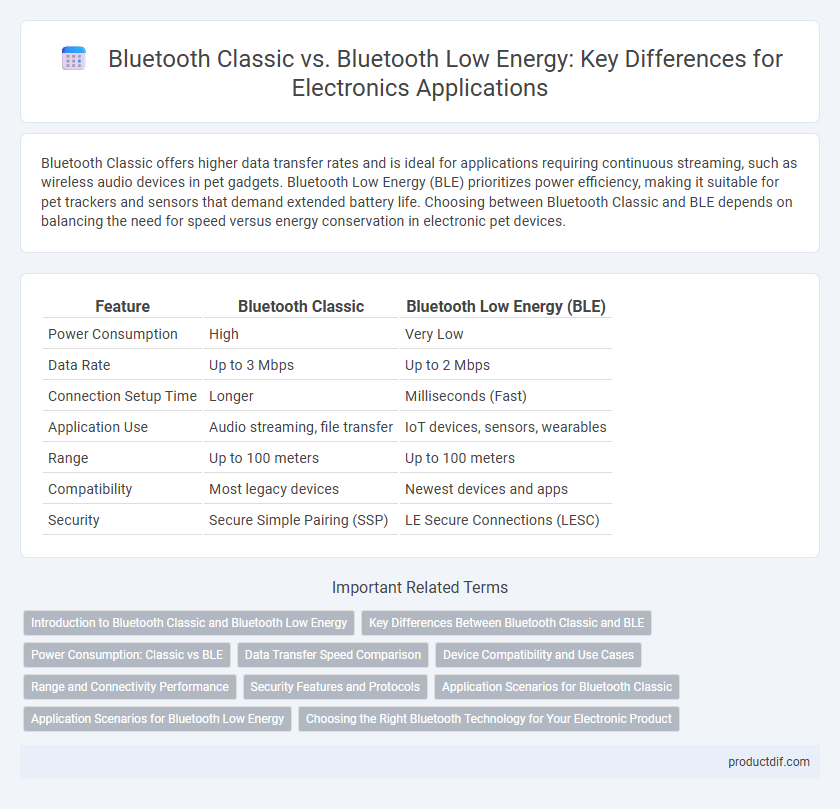Bluetooth Classic offers higher data transfer rates and is ideal for applications requiring continuous streaming, such as wireless audio devices in pet gadgets. Bluetooth Low Energy (BLE) prioritizes power efficiency, making it suitable for pet trackers and sensors that demand extended battery life. Choosing between Bluetooth Classic and BLE depends on balancing the need for speed versus energy conservation in electronic pet devices.
Table of Comparison
| Feature | Bluetooth Classic | Bluetooth Low Energy (BLE) |
|---|---|---|
| Power Consumption | High | Very Low |
| Data Rate | Up to 3 Mbps | Up to 2 Mbps |
| Connection Setup Time | Longer | Milliseconds (Fast) |
| Application Use | Audio streaming, file transfer | IoT devices, sensors, wearables |
| Range | Up to 100 meters | Up to 100 meters |
| Compatibility | Most legacy devices | Newest devices and apps |
| Security | Secure Simple Pairing (SSP) | LE Secure Connections (LESC) |
Introduction to Bluetooth Classic and Bluetooth Low Energy
Bluetooth Classic offers robust wireless communication with high data rates up to 3 Mbps, making it ideal for audio streaming and device connectivity in applications such as headphones and car systems. Bluetooth Low Energy (BLE) is engineered for ultra-low power consumption with shorter data packets, supporting IoT devices, fitness trackers, and smart home applications that require extended battery life. Both technologies operate in the 2.4 GHz ISM band but serve distinct use cases based on energy efficiency and data throughput demands.
Key Differences Between Bluetooth Classic and BLE
Bluetooth Classic offers higher data rates up to 3 Mbps, making it ideal for audio streaming and continuous data transfer, whereas Bluetooth Low Energy (BLE) prioritizes ultra-low power consumption for intermittent data exchanges in IoT devices. BLE supports rapid connection and disconnection with lower latency, optimizing battery life in wearable technology and smart home applications. Bluetooth Classic maintains backward compatibility with legacy devices, while BLE introduces a more efficient protocol stack tailored for energy-sensitive applications.
Power Consumption: Classic vs BLE
Bluetooth Low Energy (BLE) consumes significantly less power than Bluetooth Classic by optimizing data packets and operating in a low duty cycle mode. BLE reduces energy usage through short burst transmissions and efficient connection intervals, making it ideal for battery-powered devices. In contrast, Bluetooth Classic maintains continuous data streams, resulting in higher power consumption and shorter battery life.
Data Transfer Speed Comparison
Bluetooth Classic offers higher data transfer speeds, typically reaching up to 3 Mbps with Enhanced Data Rate (EDR), making it suitable for applications requiring continuous streaming or large file transfers. Bluetooth Low Energy (BLE), designed for minimal power consumption, supports data rates up to 2 Mbps with Bluetooth 5 and newer versions but generally prioritizes energy efficiency over maximum throughput. Devices leveraging Bluetooth Classic excel in speed-demanding tasks, whereas BLE optimizes for lower data volumes with extended battery life in devices like fitness trackers and sensors.
Device Compatibility and Use Cases
Bluetooth Classic offers broad device compatibility with audio devices, smartphones, and computers, making it ideal for streaming music and hands-free calling. Bluetooth Low Energy (BLE) prioritizes power efficiency and supports a wide range of IoT devices, such as fitness trackers, smartwatches, and home automation sensors. BLE's low power consumption suits applications requiring long battery life, whereas Bluetooth Classic excels in high-bandwidth use cases needing continuous data streaming.
Range and Connectivity Performance
Bluetooth Classic offers a typical range of up to 100 meters with stable, high-throughput connectivity, making it ideal for audio streaming and continuous data transfer applications. Bluetooth Low Energy (BLE) generally supports a shorter range of about 10 to 50 meters but excels in low power consumption and quick connection setup, suitable for intermittent data exchange in IoT devices. BLE's optimized protocol reduces latency and maintains robust connections in dense wireless environments despite its lower bandwidth compared to Bluetooth Classic.
Security Features and Protocols
Bluetooth Classic employs legacy security protocols such as Secure Simple Pairing (SSP) with ECDH key exchange, offering robust encryption and authentication for continuous data streaming applications. Bluetooth Low Energy (BLE) introduces enhanced security features including LE Secure Connections, using stronger Elliptic Curve Diffie-Hellman (ECDH) algorithms for key generation, ensuring improved protection against passive eavesdropping and MITM attacks in low-power devices. Both protocols support AES-CCM encryption, but BLE's lightweight design integrates these security measures more effectively for IoT and wearable technology environments.
Application Scenarios for Bluetooth Classic
Bluetooth Classic excels in scenarios requiring continuous streaming of high-quality audio, such as wireless headphones, car audio systems, and hands-free calling devices due to its higher data rate and robust connection stability. It is also ideal for applications like file transfers and wireless peripherals including keyboards and mice, where sustained data exchange and compatibility with older devices are crucial. This technology supports devices that demand consistent power consumption and longer connection durations, making it the preferred choice for audio-intensive and legacy communication tasks.
Application Scenarios for Bluetooth Low Energy
Bluetooth Low Energy (BLE) is ideal for applications requiring low power consumption and intermittent data transmission, such as fitness trackers, smartwatches, and health monitoring devices. Its optimized design supports prolonged battery life in devices that transmit small amounts of data at regular intervals, making it suitable for IoT sensors and asset tracking systems. BLE enables efficient communication in environments where continuous connection is unnecessary but energy efficiency is critical.
Choosing the Right Bluetooth Technology for Your Electronic Product
Bluetooth Low Energy (BLE) is ideal for electronic products requiring low power consumption and extended battery life, such as wearable devices and health monitors. Bluetooth Classic offers higher data transfer rates suitable for audio streaming and peripherals needing continuous connection, like wireless headphones and game controllers. Selecting the right Bluetooth technology depends on your product's power constraints, data transfer needs, and intended use cases to optimize performance and user experience.
Bluetooth Classic vs Bluetooth Low Energy Infographic

 productdif.com
productdif.com